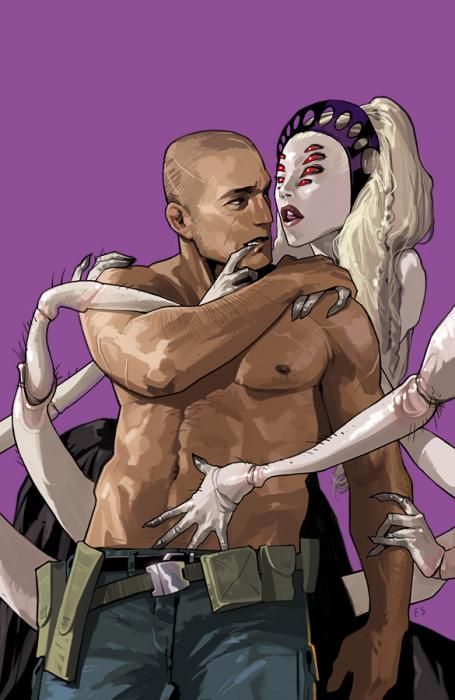"Saga" was voted #1 in CBR's Top 100 comics of 2012, and happily, in the first issue of 2013, "Saga" #9, Brian K. Vaughan and Fiona Staples continue to deliver skillful storytelling, humor and sheer aesthetic pleasure, confirming why "Saga" is both a critical and commercial hit.
"Saga" #9 is centered around interactions between The Will and Gwendolyn, Marko's ex-lover, who made her startling first appearance on the last page of "Saga" #8. Vaughan and Staples do some amazingly rapid characterization with Gwendolyn, who is a complete unknown at the beginning of "Saga" #9 but three-dimensional by the end of the issue, fleshed out with faults, strengths and a distinctive voice.
Much of "Saga" #9 is just conversations between Gwendolyn and The Will, with the most significant plot twists and forward action happening near the end of the issue. "Saga" #9 can be categorized as a "talking-heads"-type issue, but there's never been one like this, with the snappy back-and-forths happening underneath Staples' starry purple and blue skies on a beach strewn with palm trees, or amid battle camaraderie in the orange desert sands of Indica. Staples' facial expression and body language are pitch-perfect, like the moment when Gwendolyn throws her head back with a "HA!" of disbelief, and her pacing matches Vaughan's dialogue and humor beat for beat.
Vaughan and Staples also show their flair for the surreal as well as the concrete in a dream sequence for "Saga" #9 that is fascinating in its sexuality and strangeness, driven by the topsy-turvy, convoluted logic of dreams that unpack the mind's fears and current obsessions. Staples' palette is especially luscious and strange for this sequence too, without making the scene obviously set in a different consciousness.
I had serious doubts about Vaughan's introduction and use of the character of Slave Girl in "Saga" #4. She seemed transparently engineered to prove something about The Will's code of honor. It's a cliche and lazy storytelling to have a character reveal his or her moral stripes by rescuing a woman or child from gang rape or evil pimps. Conveniently, this act emphasizing the hero's toughness while justifying any violence with the victim's vulnerability. Also, in "Saga" #9, Slave Girl begins to have function in the plot behind being a symbol, and it will be interesting to see if Vaughan further develops her into being a real character.
Other minor characters, like Lying Cat, continue to be delightful. It's always funny when Lying Cat hisses accusingly, "Lying" with unerring accuracy, and fortunately for the reader, more than one character tells lies in "Saga" #9.
Staples and Vaughan build the world of "Saga" with the same skill that they develop characters. By the end of "Saga" #9, the reader has acquired new information about the setting and peoples of the world and seen some bizarre new sights, but the detail and variety is revealed casually and naturally through the action of the plot instead of shoe-horned or crammed in. Vaughan and Staples' pace of storytelling that advances plot and world-building in a gradual clip, with world-building that is easy to take in because it is neither too slow nor too fast. It hovers between comfortable and exciting, leavening the alien sights with the humanity and likability of the characters. This mixture of familiar and strange makes the world "Saga" a place that readers will look forward to visiting month after month, year after year, until the story reaches its end.

